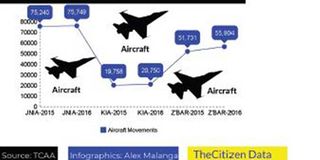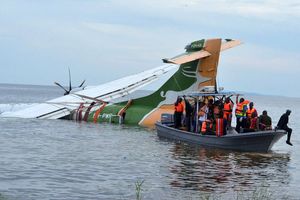Revealed: Airports operate below capacity

What you need to know:
Airlines land on airports and serve markets where they can profit, a new report shows.
Dar es Salaam. Many airports in Tanzania operate below capacity due to infrastructure challenges.
Airlines land on airports and serve markets where they can profit, a new report shows.
The International Air Transport Association (IATA) encourages developments which make airports more responsive to the needs of travellers and airlines.
Competition among airlines, according to IATA, has been a driver of innovation and cost reduction and has been beneficial to consumers as choices increased.
It states that effective competition for airports should be encouraged.
As demand for air transport continues to grow and expansion of major airports becomes more difficult, the market power of major airports is expected to become stronger, according to IATA.
In Europe alone, nearly 20 airports are forecast to be operating at full capacity throughout the day by 2030 compared with just five in 2007. Effective airport competition will be even less likely where capacity constraints at alternative airports reduce options available to consumers and airlines alike.
Effective and efficient development and functioning of airports are important for the sustainable development of air transport.
Meanwhile, the Julius Nyerere International Airport (JNIA) continues to be the busiest airport in Tanzania.
That is the situation despite government efforts to upgrade other airports.
JNIA is the leading airport in Tanzania in serving travellers and handling cargo.
According to a report by the Tanzania Civil Aviation Authority (TCAA), JNIA accounted for 49 per cent of the total passenger traffic in 2016, higher than the previous year’s 48 per cent.
The airport accounted for 73 per cent of the country’s cargo handled, well above the preceding year’s 72 per cent.
The report established that exporters of goods to Asia preferred using waterways to cut costs in ferrying goods to expensive airways.
JKNA’s market share for aircraft movements increased from 32 to 33 per cent.
The report attributes the trend to the resumption of services by airlines such as Air Zimbabwe and the introduction of Air Mauritius flights.
Rwandair Express increased its frequencies from eight to 13, Oman Air from eight to 14, Malawi Airlines from one to three, Fly Dubai from four to seven and AB Aviation from three to six.
The performance is also associated with an increase in tourist arrivals by 16.47 per cent, to 1.28 million.
The government has improved Songwe, Kigoma, Mwanza, Dodoma, Bukoba, Tabora, Shinyanga, Mtwara and Kilimanjaro airports.
During the period Zanzibar’s Abeid Amani Karume International Airport shares for passenger traffic and aircraft movement decreased from 19 and 24 per cent to 17 and 23 per cent respectively.
However, overall passenger traffic and aircraft movements increased by 20.5 and 8.1 per cent respectively as the number of tourists rose.
The airport’s cargo market share rose from eight to 11 per cent.
The Kilimanjaro International Airport’s cargo volume increased by 4.6 per cent, but its market share declined to 11 per cent, from 14 per cent.
Passenger traffic and aircraft movements stagnated at 13 and nine per cent respectively.
Overall aircraft movements increased by five per cent, thanks to introduction of Israel’s El Al Airlines from Tel Aviv.
In other airports, passenger and cargo market shares increased slightly from 20 and six per cent to 21 and 10 per cent respectively.
Aircraft movements remained static: at 35 per cent.
Nyerere International Airport (JNIA) continues to be the busiest airport, enjoying a strong position in local markets.
That is the situation despite government efforts to upgrade other airports.
JNIA is the leading airport in Tanzania in serving travellers and handling cargo.
A report by the Tanzania Civil Aviation Authority (TCAA) shows that JNIA accounted for 49 per cent of the total passenger traffic recorded in 2016, higher than the previous year’s 48 per cent.
The airport accounted for 73 per cent of the country’s cargo handled, well above the preceding year’s 72 per cent.
The report established that exporters of goods to Asia preferred using waterways to cut costs in ferrying goods to expensive airways.
JKNA’s market share for aircraft movements increased from 32 to 33 per cent.
The report attributes the trend to the resumption of services by airlines such as Air Zimbabwe and the introduction of Air Mauritius flights.
Rwandair Express increased its frequencies from eight to 13, Oman Air from eight to 14, Malawi Airlines from one to three, Fly Dubai from four to seven and AB Aviation from three to six.
The performance is also associated with an increase in tourist arrivals by 16.47 per cent, to 1.28 million.
The government has improved Songwe, Kigoma, Mwanza, Dodoma, Bukoba, Tabora, Shinyanga, Mtwara and Kilimanjaro airports.
During the period Zanzibar’s Abeid Amani Karume International Airport shares for passenger traffic and aircraft movement decreased from 19 and 24 per cent to 17 and 23 per cent respectively.
However, overall passenger traffic and aircraft movements increased by 20.5 and 8.1 per cent respectively as the number of tourists rose.
The airport’s cargo market share rose from eight to 11 per cent.
Although the cargo volume increased by 4.6 per cent at the Kilimanjaro International Airport, the market share declined to 11 per cent from 14 per cent.
Passenger traffic and aircraft movements stagnated at 13 and nine per cent respectively.
Overall aircraft movements increased by five per cent, thanks to introduction of Israel’s El Al Airlines from Tel Aviv.
In other airports, passenger and cargo market shares increased slightly from 20 and six per cent to 21 and 10 per cent respectively.
Aircraft movements remained static: at 35 per cent.




